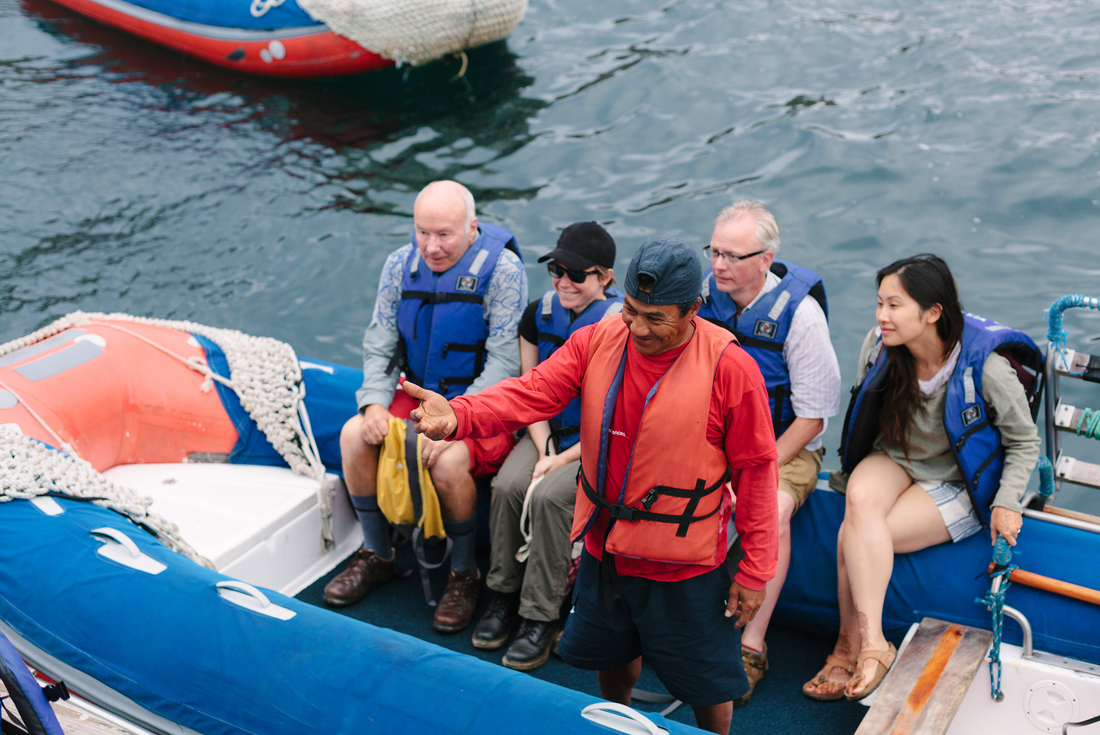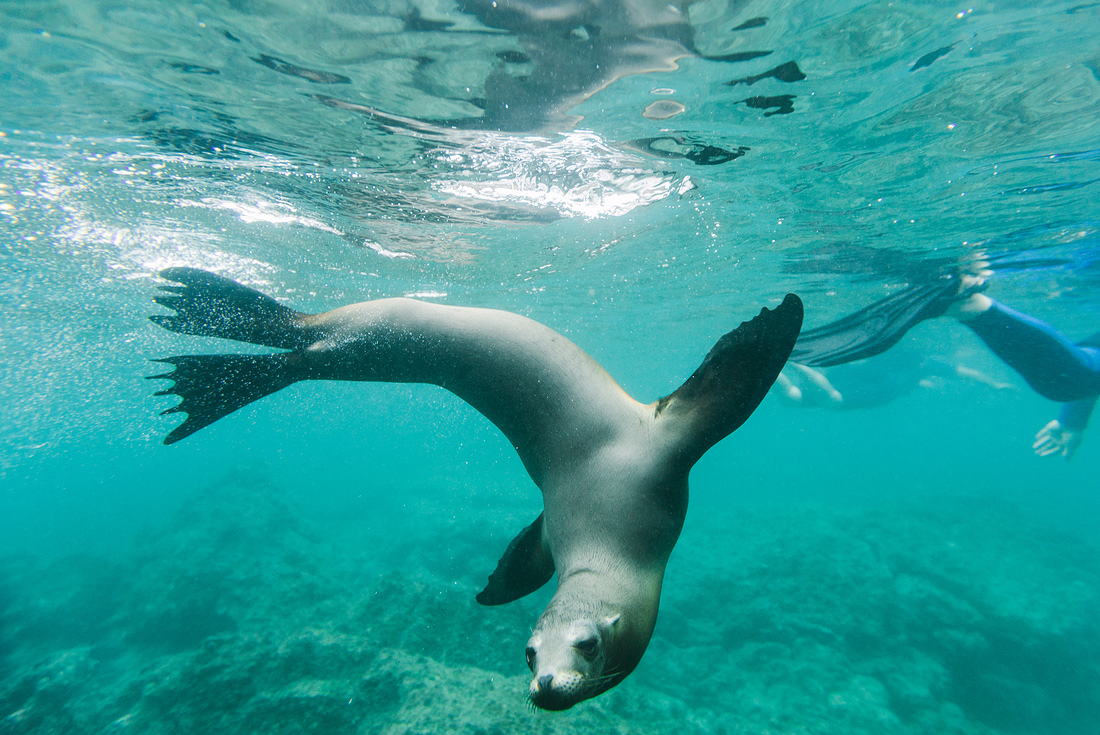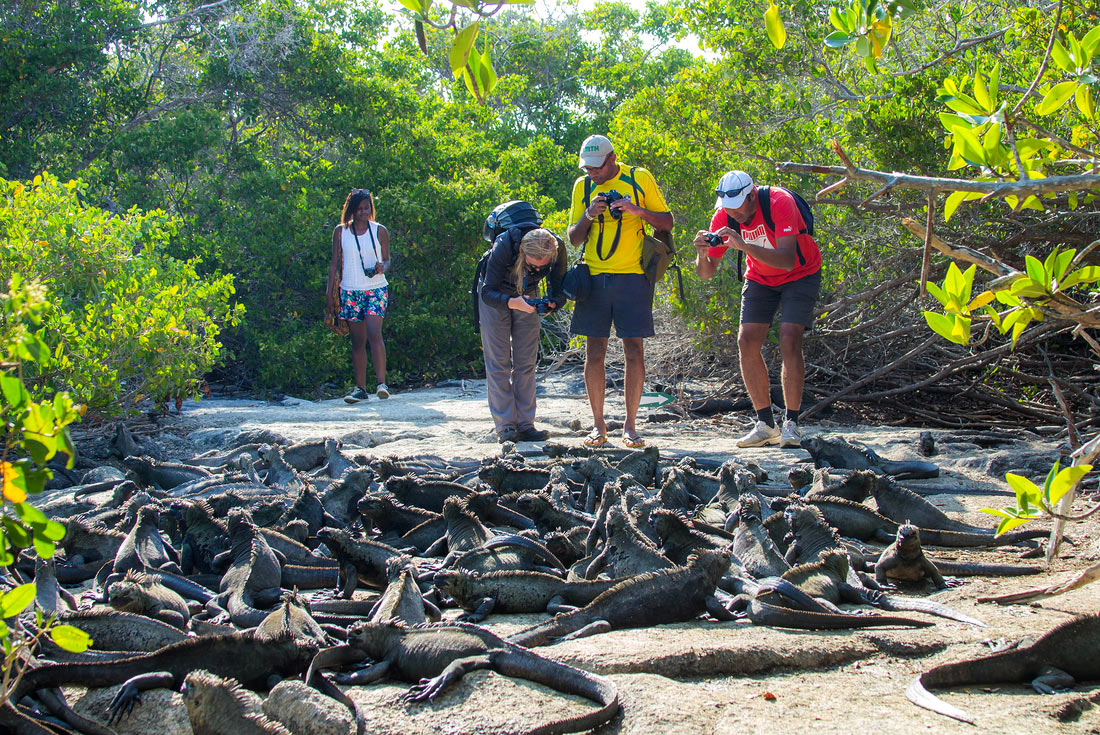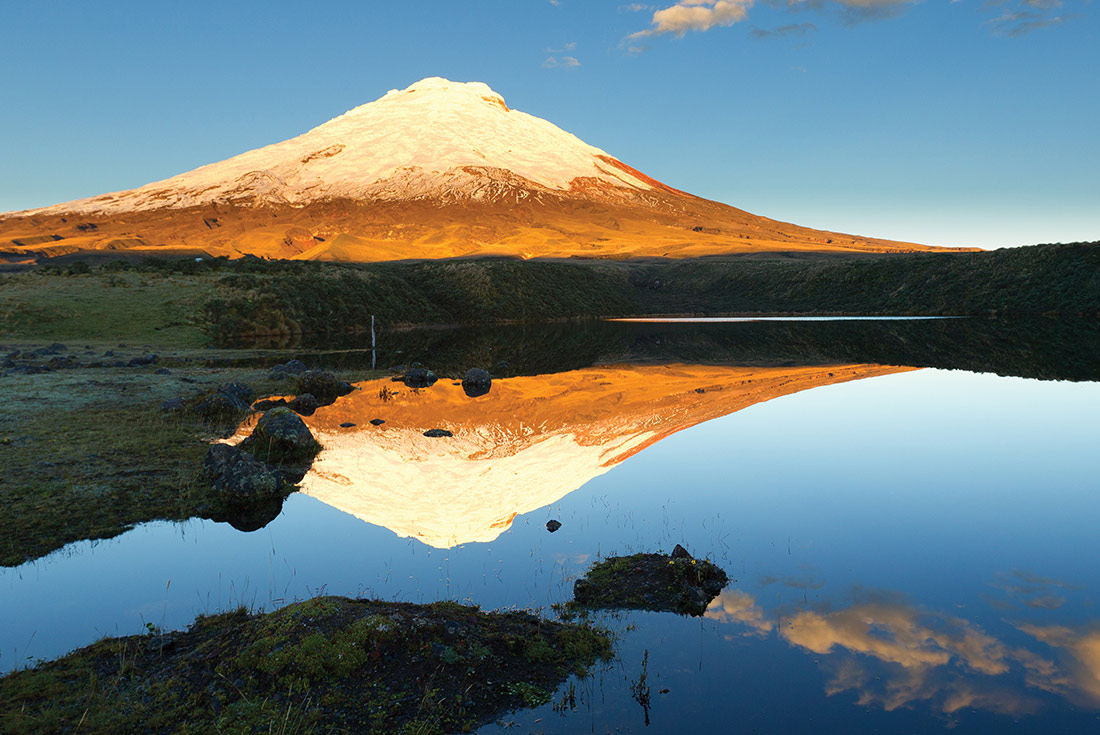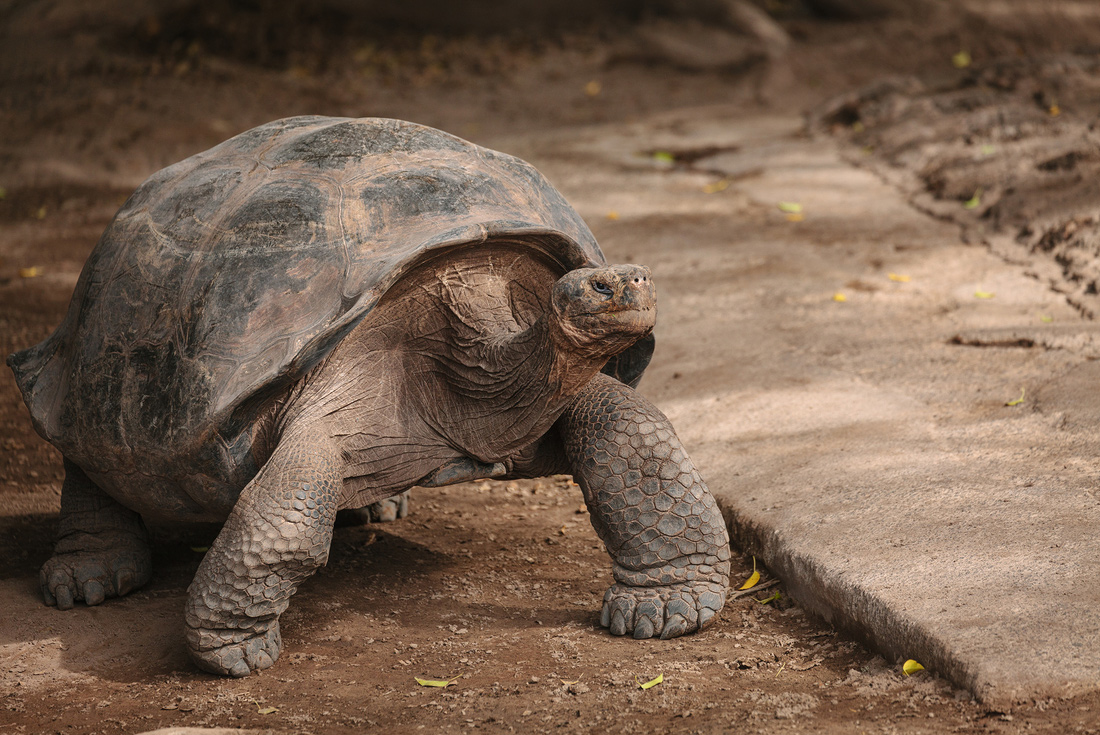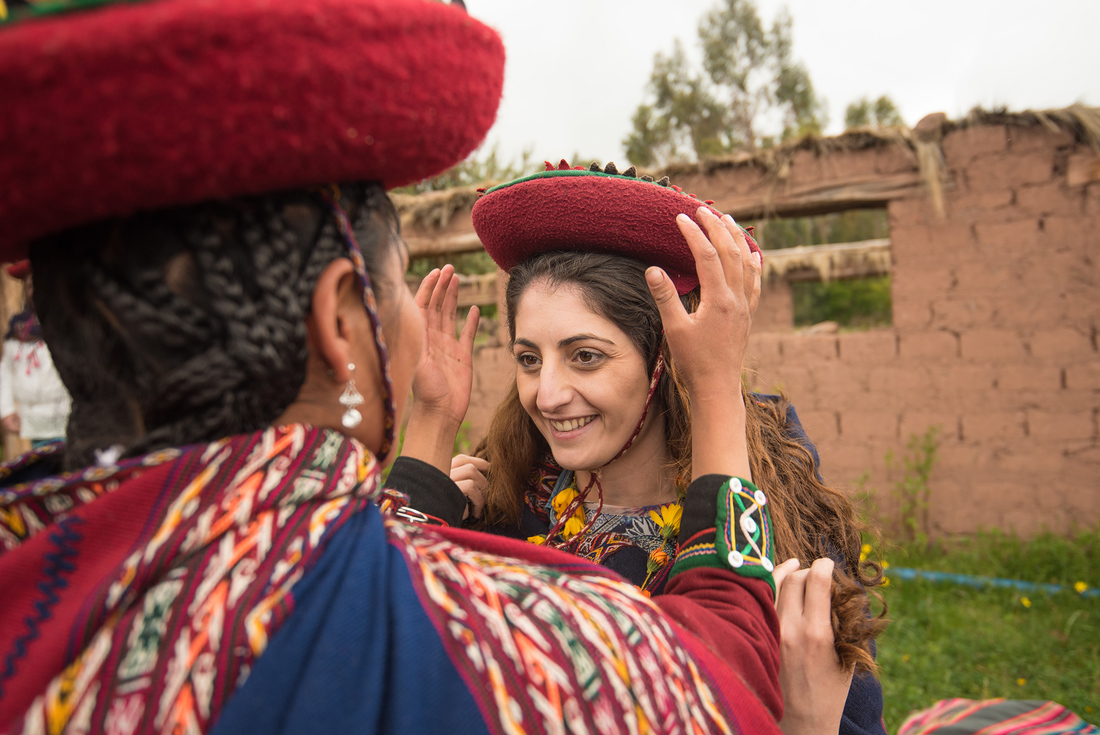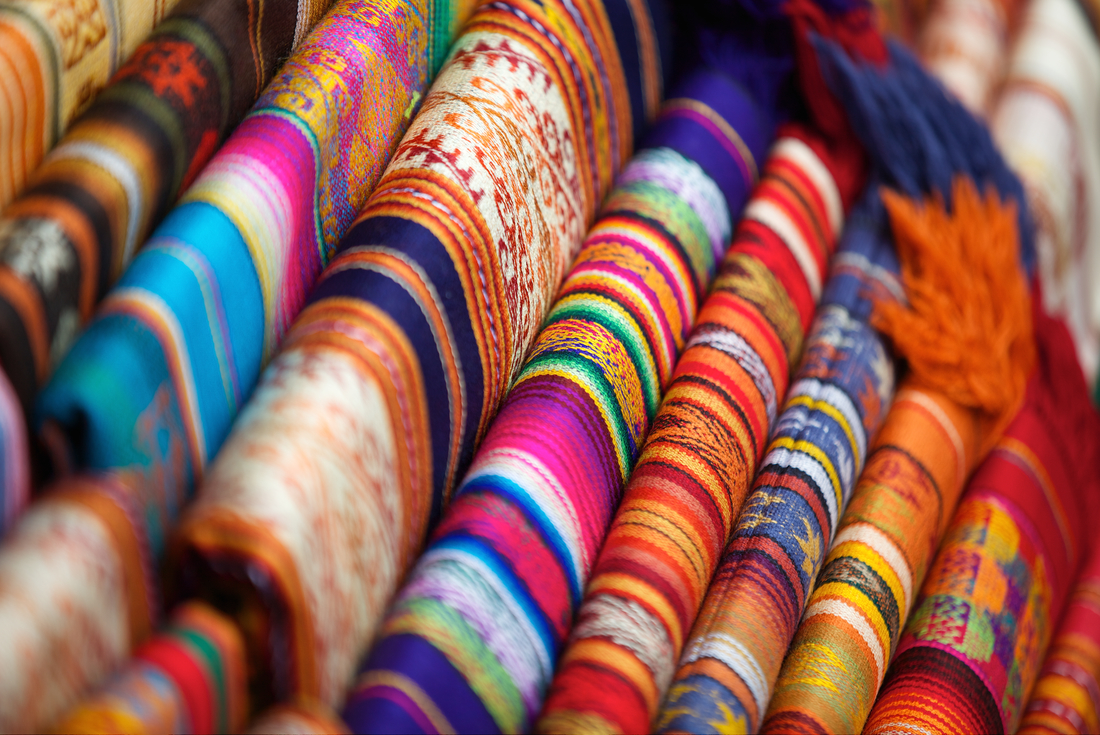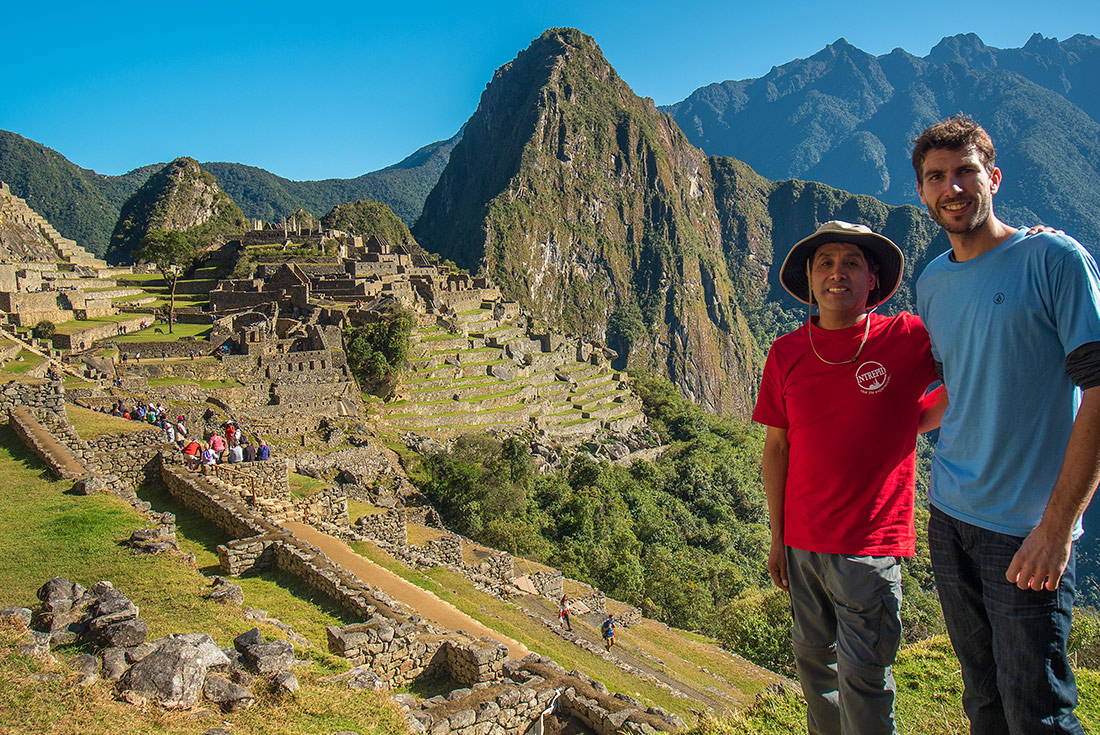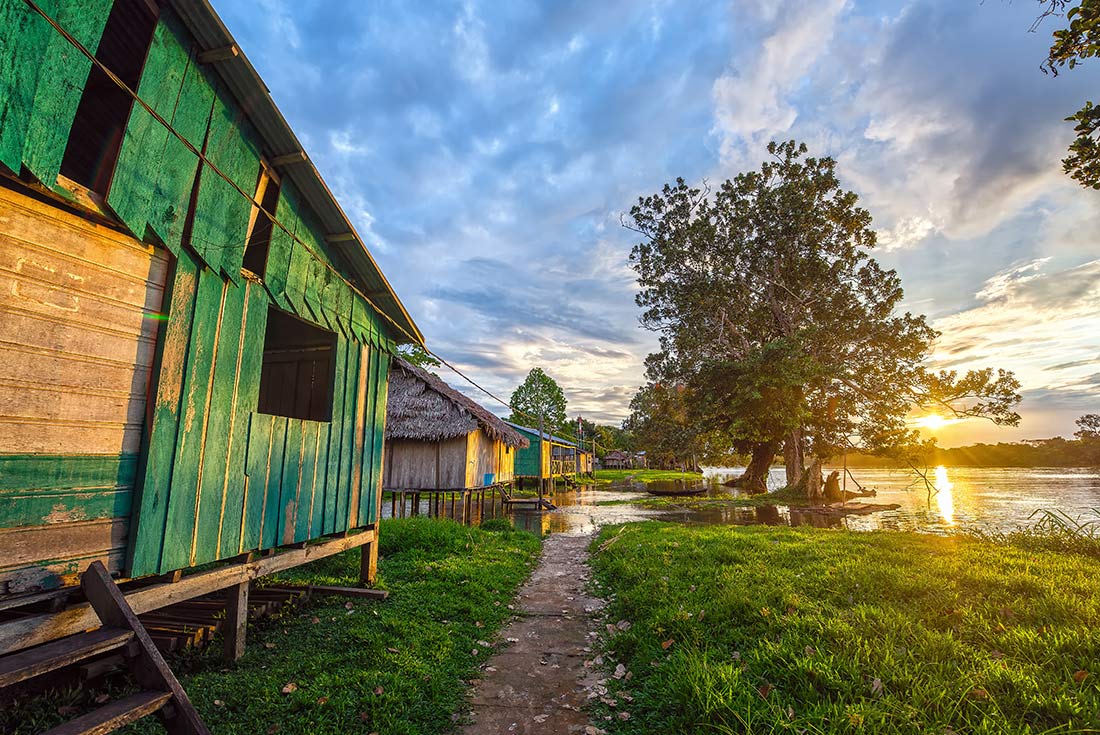- This trip gives both trekkers and non-trekkers the chance to visit Machu Picchu with Inca Trail*, Quarry Trail and train options.
- Admire the ingenuity of Inca engineering in the Sacred Valley and contemplate how stone was excavated to build the structures still standing there.
- Explore Cusco, South America's oldest continuously inhabited city. The city has ancient foundations, an interesting blend of Incan and colonial influences, and seemingly endless things to do and see.
- Snorkel the incredible marine life-filled waters of Kicker Rock, also known as Leon Dormido, one of the best snorkelling spots in the Galapagos and an absolute highlight for many travellers.
- Encounter the wildlife wonders of the Galapagos Islands up close. Giant tortoises, blue-footed boobies, sea lions, sea turtles, marine iguanas and more await.
- Hike to the top of one of the most active volcanoes in the Galapagos – the Sierra Negra – and peer into the second-largest caldera in the world.
- Marvel at the snow-capped Cotopaxi volcano – one of the largest active volcanos in the world – while hiking through Cotopaxi National Park.
- Live like a local as you’re welcomed into a family home in a sustainable community high in the hills of Ecuador, getting your hands dirty and helping with everyday tasks like reforestation projects, organic gardening or jam making, to name a few.
07 Feb 2024
Ecuador, Galapagos & Peru Explorer
GGSJC
Validity: 01 Jan 2024 to 31 Dec 2024
This unique adventure focuses on South America’s heaviest hitters – the Galapagos Islands, the Inca Trail and the Amazon Jungle. Take 24 days to explore these wildly different parts of the region. Snorkel the turtle-filled waters of Leon Dormido, then walk the cobblestone streets of Cusco. Sit on black-sand beaches watching sea lions lounge and later conquer the 4200-metre-high Dead Woman’s Pass. Witness breathtaking natural beauty among the surreal landscapes of the Ecuador Highlands and Galapagos, then wonder at the man-made elegance of Machu Picchu. This tour offers immersive and active adventure led by locals in two bucket-list favourite destinations.
Original
Explorer
Plane,Speed Boat,Bus,Private Vehicle,Taxi,Train - Route 3 only
3
The physical rating on this trip is based on you selecting to trek either the Inca Trail or Quarry Trail. Should you wish to take the train option instead of trekking, you can consider the physical level a 2-3. On Day 2 of the Inca Trail or Quarry Trail you will be walking uphill from 3000 to 4500 metres above sea level before descending steeply through big steps and difficult terrain. While this demanding walk is the main challenge our passengers face on this trip, it's also one of the highlights and worth every minute of it. You can find out more about the trekking options here: https://www.intrepidtravel.com/adventures/inca-trail-vs-quarry-trail/ We recommend that you undertake regular aerobic exercise in the months before you travel, particularly if you are not in the habit of regular exercise. Doing mountain walks or climbing long staircases with a pack is good preparation. Walking, jogging, swimming or riding a bike are all good ways to increase your aerobic fitness, which will allow you to enjoy the trekking to its fullest. More information can be found here: https://www.intrepidtravel.com/adventures/trekking-training-guide-tips/
La Cartuja Hotel
Leonidas Plaza N20-08 y 18 de Septiembre
Quito
ECUADOR
Phone: +593 2523577
La Cartuja Hotel is a charming boutique property with spacious rooms, wifi and a central courtyard to relax in. It is located within walking distance to restaurants, shops and attractions.
Please make sure that you provide your flight details no later than 14 days before departure to book your arrival transfer with us. For your confirmed arrival transfer, you’ll be met at Quito Airport International Arrivals by a transfer representative holding an Intrepid sign. In case of flight cancellations, changes, if you experience severe delays at immigration, baggage collection or customs, or if you are not able to find the driver, please contact our local office on the number in the ‘Problems and emergency contact information’ section.
Hotel Awki's Dream
Collacalle 310-31
Cusco
08003
PERU
Phone: +51 84221521
1. A single supplement is available if you’d prefer not to share a room on this trip. The single supplement excludes Days 5 and 6 (Homestay) where you will be in shared accommodation and is subject to availability. Please speak to your booking agent for further information. 2. Inca Trail* permits are sold on request basis only. Once deposit is paid and passport details provided, Intrepid will endeavor to secure a permit for you. If Inca Trail* permits are unavailable by the time you book, you can opt to hike the Quarry Trail instead https://www.intrepidtravel.com/machu-picchu-peru/quarry-trail or travel to Machu Picchu by train. 3. The Inca Trail* closes in February to allow cleaning and restoration works. If the trek portion of your trip starts in February you will be automatically booked to hike the Quarry Trail. 4. Should you choose not to hike at all, please let us know at time of booking so alternative arrangements can be made to travel to Machu Picchu by train. Without this prior warning, cancellation fees for the trekking permits may apply. 5. Full passport details are required at the time of booking in order to purchase entrance fees to certain sites. Additionally on certain trips it's needed to book bus, train or flight tickets. Delays or errors in providing this information may result in booking fees or changes to your itinerary. 6. While hiking the Inca Trail* or Quarry Trail you may be joined by other Intrepid and/or non-Intrepid travelers. 7. As you can choose different ways of reaching Machu Picchu (Inca Trail, Quarry Trail or Train), there is a small chance you may be the only traveller on your selected option. 8. Parts of your trip go above 2800 meters / 9200 feet where it is common for travelers to experience some adverse health effects due to the altitude - regardless of your age, gender and fitness. Please read the following document carefully and, during your trip, utilize the table on the back daily to record your own perspective of your general health and any symptoms you may experience: https://www.intrepidtravel.com/au/altitude-sickness 9. A Galapagos Transit Card fee of US$20 is payable on departure from Quito Airport (or whichever airport in Ecuador you are flying to the Galapagos from). The Galapagos park fee (US$100) and Isabela Port fee (US$10) are payable upon arrival to the islands (cash only). These amounts are in addition to your trip payment. 10. Ecuador has implemented COVID-19 testing requirements for entry to the country, including special conditions for Galapagos. Please refer to your government's foreign travel advice for the most up to date information. 11. Most hotels in highlands should have oxygen cylinders available, however, you may be asked to pay surcharge for use of oxygen longer than 5 - 10 min at the time. 12. Depending on the time of year, and flight availability, your Quito-Lima flight may depart in the very early hours of the morning to ensure you arrive in time for the welcome meeting. Please speak to your booking agent to confirm what time your flight is noting that the flight is purchased 30 days before departure.
All group trips are accompanied by one of our group leader or local representative. The aim of the group leader or local representative is to take the hassle out of your travels and to help you have the best trip possible. Intrepid endeavours to provide the services of an experienced group leader or local representative however, due to the seasonality of travel, rare situations may arise where your group leader or local representative is new to a particular region or training other group leader or local representative. Your group leader or local representative will provide information on the places you are travelling through, offer suggestions for things to do and see, recommend great local eating venues and introduce you to our local friends. While not being guides in the traditional sense, you can expect them to have a broad general knowledge of the places visited on the trip, including historical, cultural, religious, and social aspects. At Intrepid we aim to support local guides who have specialised knowledge of the regions we visit. If you are interested in delving deeper into the local culture at a specific site or location then your group leader or local representative can recommend a local guide service in most of the main destinations of your trip.
Most national governments provide regularly updated foreign travel advice on safety issues involved with international travel. We recommend that you check your government's advice for their latest travel information before departure and ensure that your travel insurance covers you for all destinations and activities on your trip. Please refer to our website's safety page for links to major travel advisories and updates on safety issues affecting our trips here: https://www.intrepidtravel.com/travel-alerts We strongly recommend the use of a neck wallet or money belt while travelling, for the safe-keeping of your passport, flight tickets, cash and other valuable items. Leave your jewellery at home - you won't need it while travelling. Many of our hotels have safety deposit boxes, which is the most secure way of storing your valuables. A lock is recommended for securing your luggage. Your group leader or local representative will accompany you on all included activities, however, during your trip you'll have some free time to pursue your own interests or relax and take it easy. While your group leader or local representative will assist you with the available options in a given location, please note that any optional activities you undertake are not part of your Intrepid itinerary, and Intrepid makes no representations about the safety of the activity or the standard of the operators running them. Please use your own good judgement when selecting an activity in your free time. Please also note that your group leader or local representative has the authority to amend or cancel any part of the trip itinerary if it's deemed necessary due to safety concerns. Intrepid's operational safety policies can be viewed on our website at the link below. We recommend that you take a moment to read through this information before travelling, and would appreciate any feedback on how safety is being managed on our trips.
https://www.intrepidtravel.com/safety-guidelines
PERU Demonstrations and protests occur regularly and can turn violent. National or regional strikes can be called at short notice and can disrupt domestic air travel, public transport and road networks. In the past, protestors have also caused disruption to Juliaca airport, Cusco airport and rail services to Machu Picchu. Avoid protests, demonstrations or large gatherings. Street crime, including muggings and thefts, is a significant problem in Lima, Cusco, Arequipa and other major cities. Be vigilant in public places and when withdrawing cash from ATMs. Avoid walking alone in quiet areas or at night. As with travel across the country, you should remain aware of your surroundings and avoid wearing or displaying expensive items. In the event of a robbery, do not attempt to resist attackers or take any action that puts you at greater risk. Tourists have been the targets of robbery by bogus taxi drivers. Do not hail taxis on the street and instead only use licensed telephone or internet-based taxi services whenever possible, or ask your hotel to book one for you. Be particularly careful when arriving at Jorge Chavez International Airport in Lima and only use one of the official taxi companies located at desks directly outside the arrival hall. Tourists are sometimes offered ‘spiritual cleansing’ programs in the Amazon area, Northern Peru and Cusco. These are sometimes called Ayahuasca or San Pedro and typically involve the consumption of dimethyltryptamine (DMT), an hallucinogenic drug. These practices are not regulated and people have suffered serious illnesses and in some cases death after participating in these ceremonies.
HIKING IN PERU In accordance with local laws governing tourism in Peru, trekking groups of up to and including 8 trekkers must be led by one local guide. The evacuation of an injured traveller in normal conditions may take more than 8 hours. For your own safety, it's crucial that you adhere to the local guide's safety instructions, particularly in regard to how to prevent trekkers getting separated or lost. Your leader will also conduct a safety discussion before our trekking activities.
PETTY THEFT AND PERSONAL SAFETY While travelling there is always the risk of pick-pocketing and petty theft, particularly in the more touristy cities. We recommend that you exercise caution when walking alone at night and encourage you to walk together and only on main, well-lit thoroughfares. Be particularly vigilant on public transport. Simple measures like carrying your day pack on your front, not hanging your bag over the back of your chair or on the floor and wearing a money belt will reduce any chance that your valuables should go missing.
MONEY WITHDRAWAL: In order to avoid fraud and theft, it is advisable that you withdraw money from ATMs located inside banks or guarded shops during business hours only.
SNORKELLING IN THE GALAPAGOS: Like any physical outdoor activity, snorkelling does have some safety risks. While we provide adequate training to our guides and suitable safety briefing information to our travellers, ultimately you must also be responsible for your own safety. There is no official snorkelling guide certification in Galapagos, so your activity leader will not be a professional snorkelling guide. If you have no or poor swimming ability you should not take part and can do alternative activities instead. Please discuss this directly with your guide and only take part in snorkelling if you feel confident that all safety information is clear and that you are competent to partake the activity.
WhatsApp is a popular way to communicate in Latin America. We recommended downloading WhatsApp prior to departure to communicate by text with your group leader or local representative and group members during the tour. Once downloaded, please validate your phone number before leaving home as you will not be able to do this once you arrive unless you have international roaming enabled. Connections for making phone calls through WhatsApp are not reliable, so please do not use this app to make calls to our emergency phone line.
PASSPORT You’ll need a valid passport to travel internationally and most countries require your passport to have a minimum of 6 months validity, so remember to check the expiry date. We need your passport information to get everything ready for your trip so it’s important that the information on your booking matches your passport exactly. Please take care to provide the correct details. We recommend carrying a copy of the photo page of your passport while travelling and leaving a copy at home with family or friends. VISAS & ENTRY REQUIREMENTS Many countries require a visa and obtaining the correct visa for your trip and any countries you may transit through is your responsibility. We recommend you check your visa requirements as soon as you have booked your trip. This will ensure you have time to prepare your documents and for your visa application to be processed. You can check the entry requirements for your nationality on your government's foreign travel advisories, consular websites or on our page here: www.intrepidtravel.com/visa-entry-requirements ECUADOR VISA Australians, New Zealanders, Americans, Canadians and British do not currently require a visa for Ecuador. For all other nationalities please reconfirm your visa requirements with your travel agent.
This trip gives both trekkers and non-trekkers the chance to visit Machu Picchu with Inca Trail*, Quarry Trail and train options.
Admire the ingenuity of Inca engineering in the Sacred Valley and contemplate how stone was excavated to build the structures still standing there.
Explore Cusco, South America's oldest continuously inhabited city. The city has ancient foundations, an interesting blend of Incan and colonial influences, and seemingly endless things to do and see.
Snorkel the incredible marine life-filled waters of Kicker Rock, also known as Leon Dormido, one of the best snorkelling spots in the Galapagos and an absolute highlight for many travellers.
Encounter the wildlife wonders of the Galapagos Islands up close. Giant tortoises, blue-footed boobies, sea lions, sea turtles, marine iguanas and more await.
Hike to the top of one of the most active volcanoes in the Galapagos – the Sierra Negra – and peer into the second-largest caldera in the world.
Marvel at the snow-capped Cotopaxi volcano – one of the largest active volcanos in the world – while hiking through Cotopaxi National Park.
Live like a local as you’re welcomed into a family home in a sustainable community high in the hills of Ecuador, getting your hands dirty and helping with everyday tasks like reforestation projects, organic gardening or jam making, to name a few.
This trip visits places that are at high altitude, and as a result some people can suffer from altitude sickness, regardless of age or physical health. Please see the ‘Medical and Health Information’ section of the Essential Trip Information for more detail. This trip involves a lot of walking to see the sites, and if you trek the Inca Trail* or Quarry Trail, there'll be strenuous hiking. The trip is recommended for those with a good level of fitness. Please bring comfortable footwear suitable to hiking. See the ‘Packing’ section of the Essential Trip Information for more detail. For those who trek the Inca Trail* or Quarry Trail, you'll be camping with basic facilities. It's definitely the journey as well as the final destination (Machu Picchu) that makes this way of exploring Peru worthwhile. Can't decide which trek is for you? Read up on them here: https://www.intrepidtravel.com/adventures/inca-trail-vs-quarry-trail/ This trip forms part of many longer combination trips. Some of your fellow travellers may have started earlier in Lima or elsewhere or be traveling on further after Peru, and some will be doing different routes to Machu Picchu. This trip involves a lot of travel by speedboat between the various Galapagos Islands. The rides can be quite bumpy at times, but the good news is that seasickness can often be managed with medication. Please consult a health professional to assess your suitability for such medication. Understandably, many of our passengers’ express interest in diving in the Galapagos. We are now able to assist with booking this activity, though please note that our staff are only able to do this through a provider that meets our internal safety policy. Speak to your agent at the time of booking for more information. Close proximity to the equator means sun in the Galapagos Islands is incredibly strong. Ensure you are prepared with sunscreen, a hat and sunglasses. We also recommend a rash guard. This trip does include snorkelling on multiple days throughout the itinerary. Confident swimming skills are required to take part in this part of the tour. Alternative activities will not be on offer. According to Machu Picchu visiting regulations, all visitors must follow a pre-determined route within the site. This route must be followed in one direction only, and once the guided visit commences exiting and re-entering the site is not permitted. Once the guided visit concludes, visitors must exit the site and personal exploration of Machu Picchu is not permitted. Please refer to the itinerary for details. Travellers who choose different ways of reaching Machu Picchu (Inca Trail, Quarry Trail or Train), will not follow the same routes within Machu Picchu. This means that you may not be able to have photos together, overlooking Machu Picchu. This applies to travellers on the same booking or separate bookings. This trip includes jungle hikes, which can be strenuous due to the humidity. A decent level of fitness is required to feel comfortable when exploring the jungle. While accommodation in the Amazon is clean, comfortable and ideally located, it can seem pretty basic. Please remember that this is a very remote part of the world.
GENERAL HEALTH All travellers need to be in good physical health in order to participate fully on this trip. For the safety and wellbeing of yourself and others, if you are unwell prior to travelling, please stay at home and contact us to make alternative arrangements. When selecting your trip please make sure you have read through the itinerary carefully and assess your ability to manage and enjoy our style of travel. Please note that if in the assessment of our group leader or local representative a traveller is unable to complete the itinerary without undue risk to themselves and/or the rest of the group, we reserve the right to exclude them from all or part of a trip without refund. You should consult your doctor for up-to-date medical travel information or for any necessary vaccinations before departure. We recommend that you carry a first aid kit as well as any personal medical requirements in their original packaging as they may not easily be obtained while travelling. If you are carrying medication, ensure you check your government's foreign travel advice for any local restrictions or requirements. PERU INSECT-BORNE DISEASES According to the World Health Organisation, yellow fever is widespread in Peru. Yellow fever is a potentially fatal viral disease transmitted by mosquitoes. It is preventable by vaccination. There is alo widespread transmission of Zika virus in Peru. The Australian Department of Health advises pregnant women to discuss any travel plans with their doctor and defer non-essential travel to affected areas. Malaria, dengue fever and other insect-borne diseases occur in parts of the country. Protect yourself against insect-borne diseases by using insect repellent and wear long, loose fitting, light coloured clothing and getting vaccinated against yellow fever before you travel. ALTITUDE SICKNESS If you travel above 2,500m you may get altitude sickness, which can be life threatening and can affect anyone, even if you're physically fit. You're more at risk if you've had altitude sickness before, exercise or drink alcohol before acclimatising to the altitude, or have health problems that affect breathing. See your doctor before travelling and get advice specific to you and your situation check your insurance covers emergency evacuation from altitude and related medical costs. MEDICAL TREATMENT Medical treatment can be expensive and is not always of high quality in some parts of the country. Make sure you have adequate travel health insurance and accessible funds to cover the cost of any medical treatment abroad and repatriation. YELLOW FEVER A valid international certificate of vaccination against Yellow Fever is required in many countries. You may need to present this on arrival at the airport or border crossing. Some countries will refuse entry if you are unable to present your certificate. It's also quite common for your home country to request a Yellow Fever certificate on your arrival back home. It is your responsibility to check with your doctor well in advance of leaving home about the Yellow Fever requirements for the countries you'll be visiting. ALTITUDE SICKNESS: Parts of your trip go above 2800 metres / 9200 feet where it is common for travellers to experience some adverse health effects due to the altitude - regardless of your age, gender and fitness. It even happened to Sir Edmund Hillary! Before your trip: Some pre-existing medical conditions are known to severely worsen at high altitude and be difficult to adequately treat on the ground, leading to more serious consequences. It is imperative that you discuss your pre-existing medical condition/s with your doctor. We understand certain medications are reported to aid acclimatizing to high altitude. Please discuss these options with your doctor. During your trip. While our group leader or local representative have basic first aid training and are aware of the closest medical facilities, it is very important that you are aware of the cause and effects of travelling at altitude, monitor your health and seek assistance accordingly. Please read the following document carefully and, during your trip, utilise the table on the back daily to record your own perspective of your general health and any symptoms you may experience: https://www.intrepidtravel.com/altitude-sickness
Peruvian food is delicious and becoming more trendy and popular around the world. You are sure to some away from your travels with some new favourite dishes. Simple street food is a surprise for many of our travellers to Peru - see what is in store for you here: https://www.intrepidtravel.com/adventures/peru-street-food/ DIETARY REQUIREMENTS Please let us know your diet requirements before your trip starts. Generally speaking, in bigger cities/towns vegetarians can expect a reasonable range of vegetarian venues and/or vegetarian options within tourist restaurant menus. However, vegetarianism is not the norm in this part of the world so options can be limited when eating at homestays, small local restaurants, street stalls, markets, etc. More restrictive diet requirements (vegans, coeliac, gluten intolerance, fructose intolerance, lactose intolerance etc.) can also be accommodated along this trip but you should expect a lesser variety than what you can expect at home. We recommend that, if possible, to bring your own supply of snacks with you. For those on strict Kosher or Halal diets please be aware due to cultural and language differences these are not always easy to convey when you are travelling. Your guide will do their best to assist you in translating your needs when eating out, but please be aware that these diets are not common in much of the continent and the best they may be able to accommodate is no pork or shellfish. If this will be a concern for you you may like to consider opting for vegetarian or vegan meals. We recommend researching kosher or halal options in your destination country prior to travel.
LATIN AMERICA The recommended amounts are listed in USD for the relatability of universal travellers, however the local currency is needed in the countries you are visiting. CONTINGENCY FUNDS: We try to plan for every eventuality, but there are still some things beyond our control. Please make sure you have access to the equivalent of an extra US$500 for emergencies (e.g. severe weather, natural disasters, civil unrest) or other events that result in unavoidable changes to the itinerary (e.g. transport strikes or cancellations, airport closures). Sometimes these things necessitate last minute changes to enable our trips to continue to run, and as a result there may be some extra costs involved. MEALS NOT INCLUDED: For this trip we recommend between USD25 to USD50 per day. Breakfast - If breakfast is not included, you can expect to pay USD5 to USD10 at a local café. Lunch - If you are happy with a quick snack on the go, you may get away with as little as USD5 to USD10 for a set menu at a local eatery or a sandwich and a drink at a café. On the other hand, lunch at a tourist restaurant can cost USD10 to USD15. Dinner - At dinner time, your group leader or local representative will normally recommend restaurants where you can safely try the local specialties of the region. Expect meals to cost USD12 to USD25 for a main. These are indicative prices only. If you are on a tight budget and happy to eat local food you can eat cheaper than this. If you want to try the finest food at the finest restaurants, then you can expect meals to cost as much as in Western countries. CREDIT CARDS & ATMs: ATMs are widely available in major towns and cities across Latin America. Credit cards can generally be used in tourist shops and restaurants. Visa and Mastercard are generally preferred over American Express, Diners, etc. Smaller venues take cash only. TIPPING: Gratuities aren’t compulsory on your trip, but they can make a big difference to locals employed in the tourism industry. We suggest carrying small notes of local currency around as you go. It’ll make tipping easier. The recommended tipping amounts are listed in USD for the relatability of universal travellers. Usually around USD5 – USD10 a day to cover tips is fine, but your leader might raise the idea of a group tip kitty. Each traveller contributes an equal amount to the pool, and your leader can pay the tips as you go. SOUTH AMERICA - General Tipping Guide: To give you a bit of guidance, we’ve put together the following tipping notes. These are just suggestions, based on feedback from past travellers and our staff on the ground. - Restaurants: Local markets and basic restaurants - round your bill up to the nearest USD1. More up-market restaurants we suggest 10% to 15% of your bill. - Local guides: There might be times during the trip where you’ll have a specialist local guide alongside your trip leader. We suggest tipping these guides about USD2 – USD3 per day. - Drivers: You may have a range of drivers on your trip. Some may be with you for a short journey while others may be with you for several days. We suggest USD1-USD2 per day for drivers. - Your Tour Leader: You may also consider tipping your tour leader for outstanding service throughout your trip. The amount is entirely a personal preference, however as a guideline USD2-USD4 per person, per day can be used. Of course you are free to tip more or less as you see fit, depending on your perception of service quality and the length of your trip. Remember, a tip is not compulsory and should only be given when you receive excellent service. PERU TREKKING - General Tipping Guide: We recommend you carry the below suggested amounts with you during the trek and that you carry small bills as this makes splitting the tip an easier process. The last day of the trek the tipping will be broken down into envelopes – one per porter, assistant guides and guide. Inca Trail: we suggest a total tipping amount of PEN120 to PEN180 per person (approximately USD 37 to USD 55). This is generally the tipping breakdown: Porters, cook and assistants PEN 80 to PEN 120 Assistant guide: PEN 12 to PEN 20 Guide: PEN 27 to PEN 40 Quarry Trail: the suggested total tipping amount per person is PEN 120 to PEN 135 (approximately USD 37 to USD 42). This is generally the tipping breakdown: Porters, cook and assistants PEN 90 Assistant guide: PEN 9 to PEN 15 Guide: PEN 20 to PEN 30
Most travellers prefer to take a small to medium wheeled suitcase, which is a great size for the packing capacity in our private vehicles. Whatever you take, be mindful that you will need to be able to carry your own luggage, handle it at airports, take in/out of accommodation and perhaps even walk short distances. Generally speaking, we recommend you pack as lightly as possible. You'll also need a day pack/bag for activities and day trips. In terms of weight, airlines generally allow a maximum of 20kg for check in luggage. Other than the items and clothing you always need on a trip, below we have listed packing suggestions specific for this trip:
ESSENTIAL: - Closed-in shoes will help to protect your feet from cuts and scratches when walking through cities as well as bush/grass-lands, and will also act as a barrier protection in rare cases against bites or stings - Sun protection - hat, sunscreen, sunglasses
RECOMMENDED: - Soft and/or hard copies of all important documents e.g. air tickets, passport, vaccination certificate, etc. and keep the hard copies separate from the originals. While not valid, a copy makes it very much easier to obtain replacements if necessary - Water bottle. We recommend at least a 1.5 litre capacity. The sale of bottled water contributes to an enormous environmental problem around the world. In addition to the water in bottles, the production of a 1 litre plastic bottle takes 2 litres of water and 200ml of oil. A large proportion end up in limited landfill or discarded in waterways and natural environments - Electrical adapter plug (view www.kropla.com) - Personal medical kit. Your guide will carry a large kit but we recommend you carry items such as mild pain killers, electrolytes and bandaids. - Insect repellent - Watch/Alarm clock or phone that can be used for both OPTIONAL: - Ear plugs to guard against a potential snoring room-mate - Phrase book VALUABLES: Please try to avoid bringing unnecessary valuables, and use your hotel safe. It’s also a good idea to purchase a money belt or pouch that is easily hidden. LAUNDRY Laundry is available at many hotels and towns during this trip, although you might need to wait for a two-night stop in order to make sure you get it back in time. While laundry at hotels is usually charged by the item, laundromats usually charge by the kilo, which is generally inexpensive (about USD 2 per kilo)
GALAPAGOS SPECIFIC In addition to our packing list above, you may want to consider bringing the below items when traveling to the Galapagos: Sandals (something with a hard sole that you can get wet) Rash Guard to prevent sun exposure Beach Towels: It's not necessary to bring a beach towel as all of our hotels provide them for the duration of your stay.
PERU TREKKING Tents and sleeping mats are provided for the duration of your Peru trek. At the pre-trek briefing you will be given a small duffle bag to pack your clothes for the trek, please note there is a 5kg limit, this includes your sleeping bag. In addition to the general packing list above, please ensure you bring these items if you are trekking in Peru. Passport: You MUST take your passport, a photocopy is not sufficient. It's important the passport matches the details your provided us when booking this trip (Keep it in a plastic bag in case of rain) Sleeping bag: You will need a good warm sleeping bag for the trek. Sleeping bags can be hired for US20-25, please let your Tour Leader know at the trek briefing. A four season (or -10) bag is recommended especially for the winter months. At other times you will probably be fine in a 3 season (or -5) bag although this depends on how much you feel the cold and is given as a guideline only. Silk sleeping bag liner: Especially recommended if you plan to hire a sleeping bag but can also give your own bag added warmth. Pillow Pillows are not provided on the trek and it's your personal preference if you wish to bring one along. If you decide to bring a pillow then we do suggest packing a travel friendly option, something that can be easily packed into your small duffle bag. Trek Poles: Trek poles are not required, it's a personal preference. We recommend hiring these at the pre-trek briefing for approximately US$10 per pole as it will save you carting them around for the remainder of your travels. Day Pack: A day bag that has easy access to water bottles (external side pockets) or a day pack with a built in hydration bladder. This bag only needs to be large enough to hold the few things you need during the day (hat, water, camera, snacks, rain jacket etc) Water bottle: You should be carrying at least 2 litres of water daily, while trekking. Depending on whether you have a hydration bladder in your bag or not we recommend bringing two (1 litre) bottles that can be refilled on the trail with boiled water, which will be supplied daily. Waterproof, well worn-in walking boots: Good quality, comfortable footwear is essential. Whatever you wear on your feet the most important thing is comfort. It is vital to ensure your boots are well worn in and lightweight. Ankle support and waterproofing is recommended but if you already have something comfortable with good grip on rocks then don’t go rushing out to buy new boots – you are better off with your well-worn in pair! Walking clothing in layers: (E.g. zip off trousers, fleece, T-shirts). It’s a personal choice as to how many items you bring however please remember there’s a 5kg limit. We recommend the following; • 2 Pairs of long Walking Trousers (Zip off are a very hand choice but not a necessity) • 2 T-shirts • 1 Pair of shorts • Rain Jacket or Poncho (Poncho can be purchased locally for a $2-3) • 4-5 Pairs of Thick socks Warm clothing for night time: Fleece, long pants, woollen hat, gloves. Thermal underwear: Thermal wear is highly recommended, being light, warm and will keep you warm at night. Sunscreen, sunglasses and sunhat Personal medication and basic first aid kit: Band-Aids, Imodium, Panadol, rehydration sachets. Camera and spare batteries, memory cards or film: Please note: there are no electrical outlets on the trek so make sure you fully charge and or have spare batteries. Snacks: Chocolates, chips, biscuits, energy bars. Snacks are provided during the trek but you may like to bring one or two extras just in case. If you have a dietary requirement then be recommend bringing some suitable snacks from home. We will accommodate you for Breakfast, lunch and dinner however for snacks it’s recommended to bring some just to be safe. Head torch or Standard Torch (flash-light) (Very Important) and spare batteries. Tropical strength insect repellent. Antiseptic hand gel. Flip-flops / thongs / jandals: If you wish to have a shower on the third night and to wear around camp after a long day of trekking. Ear Plugs: In case your tent ‘roomie’ is a snorer. Plastic bags: To keep your belongings and clothes dry (wrap everything in plastic bags). Toilet paper: Most important! Also small plastic bags or zip lock bags for rubbish which can then be thrown in the main rubbish bag provided by the porters. Please don’t dispose of your toilet paper on the ground! Wet wipes and or Face wipes: These are an essential and will come in handy after a long day of trekking and no showers. Small towel and basic personal toiletries: On the third night of both the Inca Trail and the Inca Quarry there is an opportunity to have a shower so bring travel size shampoo and shower gel if you would like.
See here for more information about the best times to trek in Peru: https://www.intrepidtravel.com/adventures/hiking-seasons-in-peru/ INCA TRAIL CLOSURES The Inca Trail closes in February each year to allow for cleaning and restoration works. If you are booked to hike the Inca Trail at this time you will be you will be rebooked to hike the Quarry Trail. FLOODING & LANDSLIDES: The wet season in Peru is from November to April. During this time it can be rainy or even snow heavily in the Andes. There have been occasions of torrential rains and flooding in some parts of the country, including Cusco. During the wet season landslides and inclement weather can cause disruption to road and rail travel as well as trekking and hiking routes. These can include Cusco, the routes to Machu Picchu and the north of Peru. EARTHQUAKES: Peru is in an active earthquake zone and there are frequent tremors. If in a building when an earthquake strikes keep away from the windows and make your way to the safe zones marked in most buildings with an ‘S’ sign. If you are outside keep away from buildings and other areas where objects, like trees or power lines, could fall. SEA SICKNESS- GALAPAGOS: Please note that from June to August the water is rougher than usual. Consequently travel times will be longer than usual. If you suffer from seasickness you may want to reconsider travelling during this period.
We like to think our Intrepid travellers are all connected by a love of adventure and passion for seeing the world in a different way. We've laid down a few non-negotiable rules to ensure everyone feels connected, comfortable and safe on our trips. We ask that you respect your fellow travellers, group leader or local representative, and local people and places we visit in all circumstances. We don't tolerate any forms of violence and expect that you follow the local laws, customs and regulations in any destination we travel to. Any behaviour contrary to the above, including any behaviour that prevents our staff from performing their duty of care or continuing the itinerary as planned, may result in travellers being removed from the trip. If you consume alcohol while travelling, we encourage responsible drinking and expect you to abide by local alcohol laws. To ensure the well-being of everyone on the trip, all decisions made by group leaders or local representatives and ground staff are final. Romantic relationships between travellers and group leader or local representative are not permitted while on trip. By travelling with us, you agree to comply with these rules and the laws and customs of all countries visited. If something is concerning you during your travels with us, please speak to your group leader or local representative immediately. Alternatively, contact us on the emergency contact number detailed in your Essential Trip Information’s Problems and Emergency Contact section. Strict rules apply in the Galapagos Islands aimed at protecting and preserving its unique biodiversity. Intrepid strongly agrees and supports these rules which range from times of the day that a destination can be visited to the distance kept between people and wildlife – all these rules will be explained in more detailed by your crew on the ground. Not adhering to these rules can lead to hefty fines for travellers and can result on Intrepid losing the license to operate in the Galapagos Islands – these rules must be adhered to by all, without exception. For more information, please follow this link: http://www.galapagos.org/travel/travel/park-rules/
Can’t stop thinking about your adventure? Tell us all about it! We read each piece of feedback carefully and use it to make improvements for travellers like you. Share your experience with us at: http://www.intrepidtravel.com/feedback/
While we always endeavour to provide the best possible holiday experience, due to the nature of travel and the areas we visit sometimes things can and do go wrong. Should any issue occur while you are on your trip, it is imperative that you discuss this with your group leader or local representative straight away so that they can do their best to rectify the problem and save any potential negative impact on the rest of your trip. We recognise that there may be times when your group leader or local representative may not be able to resolve a situation to your satisfaction - if this is the case, please ask the group leader or local representative to speak to their direct manager. You may also choose to provide details in your online feedback, which we ask you to complete within 30 days of the end of your trip. Please do be aware that it is very difficult for us to provide any practical help after the trip is completed, so informing us while still travelling will give us the opportunity to resolve the issue in real-time. For general contact details please use the following page: http://www.intrepidtravel.com/ourtrips/contact/ In case of a genuine crisis or emergency, you can reach our local office on the numbers below: Available for phone call or WhatsApp call on +51 996 055559 Lima, +51 940 512701 Cusco Intrepid’s Local Operator Ecuador: +593 9 94014877 Intrepid’s Local Operator Ecuador: +593 9 94014877 / +593 9 99469636
Our Responsible Travel Policy outlines our commitment to preserving the environment, supporting local communities, protecting the vulnerable, and giving back to the places we travel. All our trip group leaders or local representatives, suppliers, and staff are trained on these principles and are core to us delivering sustainable, experience-rich travel. Explore the different parts of our Responsible Travel Policy by visiting: https://www.intrepidtravel.com/responsible-travel Love wildlife? Us too. We believe nature should be protected, respected and never exploited for our entertainment. That’s why we design all of our wildlife trips and experiences to meet the standards set out in our animal welfare guidelines (https://www.intrepidtravel.com/en/animal-welfare), created in collaboration with World Animal Protection. This ensures that the unforgettable animal encounters our travellers rave about are conducted responsibly, with the utmost respect for all creatures. What does that mean for you? Well, we never ride, feed or handle wild animals for a start. Take a closer look at our animal welfare policy (https://www.intrepidtravel.com/sites/intrepid/files/Intrepid_Travel_Animal_Welfare_Policy.pdf) to learn more about how we champion responsible, cruelty-free experiences on our trips, and see how you can help make a difference when you travel with our animal-friendly travel tips (https://www.intrepidtravel.com/en/how-be-better-traveller-wildlife).
We created our not-for-profit, the Intrepid Foundation because you – our travellers – told us you wanted to make an even greater impact in the communities you visit. The Foundation works by teaming up with partners around the world so that together we can deliver greater positive impact at scale. Partners are identified by our local staff who live and work in our destinations. They harness their powerful community connections to determine the issues that matter most and select local partners who can deliver real solutions. Since 2002, the Intrepid Foundation has raised more than $14million dollars and supported more than 160 communities worldwide. Now, with over 40 partners all over the world, your donations are helping to restore forests in Kenya, empower women in Honduras and promote elephant welfare in Laos, to name just a few. For more information about the Intrepid Foundation, please ask your group leader or local representative or visit our website: http://www.theintrepidfoundation.org/ This trip supports Awamaki, who empower indigenous women in Peru with educational opportunities and jobs that provide financial independence. They offer lessons in quality control, product development and technical skills training for women artisans in rural Andean communities. Donations support the growth and development of their programs to lift more women into financial independence. Intrepid will double the impact by dollar-matching post-trip donations made to The Intrepid Foundation. To find out more or make a donation, visit https://www.theintrepidfoundation.org/t/awamaki
PERU Due to local energy supply and infrastructure issues, please be prepared for some cold showers while travelling in Peru. CAMPING On camping nights we stay in twin share tents, set up by our porters. If you have booked a single supplement, a single tent will be provided. Foam camping mats are supplied but you will need to bring your own sleeping bag. See the 'Packing' section for more information.
Travel insurance is compulsory on all our trips for those travelling internationally. We require that at a minimum you are covered for medical expenses including emergency repatriation. If you are travelling within your home country or region please confirm before travel that you are entitled to access the public medical system easily should an accident occur. We strongly recommend all travellers have a policy that also covers personal liability, cancellation, curtailment and loss of luggage or personal effects. For international trips, you will not be permitted to join the group until evidence of travel insurance and the insurance company's 24-hour emergency contact number has been sighted by your group leader or local representative. If you have credit card insurance your group leader or local representative will require details of the participating insurer/underwriter, the level of coverage, policy number, and emergency contact number rather than the bank's name and your credit card details. Please contact your bank for these details prior to arriving in-country. For travellers who reside within the European Union, Switzerland or USA the requirement to purchase travel insurance cannot be compulsory. However the purchase of travel insurance is still highly recommended, and travellers from these regions who decline travel insurance when travelling outside of their home region must sign a Travel Insurance Waiver Form at the Group Meeting, recognizing personal responsibility for emergency medical and repatriation costs should they arise. For assistance with travel insurance or other services, please visit the link below: https://www.intrepidtravel.com/booking-resources/our-services The Ecuadorian government has declared that travel insurance is compulsory for all travellers entering Ecuador. Proof of insurance may be requested at upon entering the country by immigration officials.
As you travel on a group trip you will be exposed to all the pleasures and maybe some of the frustrations of travelling in a group. Your fellow travellers will probably come from all corners of the world and likely a range of age groups too. We ask you to be understanding of the various needs and preferences of your group - patience with your fellow travellers is sometimes required for the benefit of everyone's travel experience. Remember too that you have responsibilities to the group. If you are requested to be at a place at a certain time, ensure that you don't keep the rest of the group waiting. We have found time and time again that the very best trips we operate are those where the dynamics within the group work well - this takes just a little effort on your part. Due to privacy reasons, we are unable to provide you with contact details and any personal information about your fellow travellers booked on your trip prior to departure. SOLO TRAVELLERS The beauty of our style of travel is that it caters to travellers who are travelling solo and who want to meet and share experiences with like-minded people. On our trips rooming is organised on a twin-share basis. We pair up solo travellers with another traveller of the same gender as per the gender marker on each of their passports. As a responsible tour operator, we strive to create a safe and inclusive environment for everyone. In the case that your gender identity differs from what is indicated on your passport, please contact us so that we can discuss rooming options with you. We also have an optional single supplement available on most trips for travellers who prefer to have their own room. Please note that this only applies to accommodation during the tour. Pre-trip and post-trip accommodation booked through us will be on a single room basis. On a small selection of itineraries some accommodations are booked on an open gender, multi-share basis (for example on a felucca in Egypt or an overnight train in Vietnam). In those instances it will clearly be stated in our Essential Trip Information prior to booking and travelling. COMBINATION TRIP: Please note that this trip forms part of longer combination trips. Some of your fellow travellers may start their journey prior to Cusco, may be on a different option to Machu Picchu or or may continue travelling on after this section of the trip is completed.
ITINERARY CHANGES Our itineraries are updated regularly throughout the year based on customer feedback and to reflect the current situation in each destination. The information included in this Essential Trip Information may therefore differ from when you first booked your trip. It's important that you review this information prior to travel so that you have the latest updates. Due to weather, local conditions, transport schedules, public holidays, political unrest or other factors, further changes may be necessary to your itinerary once in-country. Your group leader or local representative will keep you up to date with any such changes once your trip is underway. OPTIONAL ACTIVITIES A selection of optional activities that have been popular with past travellers are listed in the day-to-day itinerary. This isn't an exhaustive list and should be used as a guide only for some of what might be available. Prices are approximate, are for entrance fees only, and don’t include transport to and from the sites or local guides unless indicated. All activities are subject to availability, and maybe on a join-in basis. It may not be possible to do all the activities listed in the time available at each destination, so some pre-planning for what you are most interested in is advised. When it's recommended that travellers pre-book these activities, look for a note in the Special Information section of the day-to-day itinerary. For most, they can either be organised independently on the day, or let your group leader or local representative know you are interested at the Welcome Meeting and they can assist. Where activities are considered medium or high risk, we work with operators whose safety and credentials we have sighted and assessed. Although it is possible that you may find the same activity cheaper with another operator on the ground, we cannot vouch for the safety or quality of that operator. Medium and high-risk activities not listed above have not been assessed by us and as such our staff and group leader or local representative are unable to assist you with organising these activities. Activities that contravene our Responsible Travel policies are also not listed. Please remember that the decision to partake in any activity not listed is at your own discretion and risk. DEMONSTRATIONS & STRIKES: Demonstrations and protests, often in response to local labour or social issues, occur regularly in Peru. National strikes can be called at short notice and can cause disruption to road networks leading to inevitable itinerary changes. We will do everything possible for these changes to be at little or no extra cost; however in such circumstances we find that travellers may need to use their contingency funds to cover the costs of itinerary changes. HEAVY RAIN ON THE INCA TRAIL If it rains heavily for a number of consecutive days, the terrain at the third campsite (Wiñaywayna) can become unstable, increasing the danger of landslides and making it unsafe to camp. This occurs mostly during the wet season (December to March) although it can also happen at any time of the year. Your trekking guide may assess that it's safer to spend the third night in a hotel in Aguas Calientes (Machu Picchu), or if available, to camp at Puente Ruinas campsite. You may need to use your contingency funds to cover any additional costs. An letter can be provided for lodging a travel insurance claim for these costs.
Route 1 - Inca Trail: Camping with basic facilities (3 nights),Hotel (16 nights),Jungle Eco Lodge (2 nights),Homestay (2 nights). Route 2 - Quarry Trail: Camping with basic facilities (2 nights),Hotel (17 nights),Jungle Eco Lodge (2 nights),Homestay (2 nights). Route 3 - Train option: Hotel (19 nights),Jungle Eco Lodge (2 nights),Homestay (2 nights)

